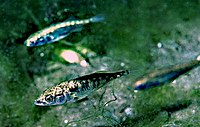
Mapping the variation in spider body colouration from an insect perspective
Sign Up to like & getrecommendations! Published in 2017 at "Evolutionary Ecology"
DOI: 10.1007/s10682-017-9904-5
Abstract: Colour variation is frequently observed in spiders. Such variation can impact fitness by affecting the way spiders are perceived by relevant observers such as prey (i.e. by resembling flower signals as visual lures) and predators… read more here.
Keywords: spider; visual systems; variation; pattern ... See more keywords

Female Brazilian whiptail lizards (Cnemidophorus ocellifer) prefer males with high ultraviolet ornament reflectance
Sign Up to like & getrecommendations! Published in 2017 at "Behavioural Processes"
DOI: 10.1016/j.beproc.2017.05.009
Abstract: Conspicuous colouration is an important way of social communication in many taxa. The role of ultraviolet (UV) signals in intraspecific communication has only recently been studied in lizards, and there is not a general understanding… read more here.
Keywords: preference; colouration; reflectance; brazilian whiptail ... See more keywords

Relevance of body size and shell colouration for thermal absorption and heat loss in white garden snails, Theba pisana (Helicidae), from Northern France.
Sign Up to like & getrecommendations! Published in 2017 at "Journal of thermal biology"
DOI: 10.1016/j.jtherbio.2017.06.001
Abstract: The internal temperature of land snails depends on environmental factors, such as exposure to electromagnetic radiation and airflow as well as biotic factors including shell size, shell colouration and thickness or the resting position of… read more here.
Keywords: temperature; colouration; size; shell ... See more keywords

Female polymorphism and colour variability in Argia oculata (Coenagrionidae: Zygoptera)
Sign Up to like & getrecommendations! Published in 2017 at "Neotropical Biodiversity"
DOI: 10.1080/23766808.2017.1398037
Abstract: Body colouration frequently possesses a communicative function, particularly in species with colour polymorphism and developed visual systems as odonates, and also affects the conspicuousness of animals in relation to the background. Therefore, these factors can… read more here.
Keywords: argia oculata; female polymorphism; colouration; colour variability ... See more keywords

Genetic and environmental drivers of colour and pattern in the Australian jacky dragon (Amphibolurus muricatus)
Sign Up to like & getrecommendations! Published in 2022 at "Journal of Evolutionary Biology"
DOI: 10.1111/jeb.14066
Abstract: The underlying drivers of variation in the colouration (colour and pattern) of animals can be genetic, non‐genetic, or more likely, a combination of both. Understanding the role of heritable genetic elements, as well as non‐genetic… read more here.
Keywords: colour pattern; amphibolurus muricatus; jacky dragon; non genetic ... See more keywords

Rattlesnake colouration affects detection by predators
Sign Up to like & getrecommendations! Published in 2020 at "Journal of Zoology"
DOI: 10.1111/jzo.12786
Abstract: Crypsis, or the ability of an animal to avoid detection by other animals, is strongly impacted by an animal’s colouration and pattern. Crypsis may be especially important for ambush foragers, which spend much of their… read more here.
Keywords: colouration affects; detection; detection predators; colouration ... See more keywords

Flexibility of nuptial colouration in a unique ecotype of threespine stickleback (Gasterosteus aculeatus)
Sign Up to like & getrecommendations! Published in 2021 at "Canadian Journal of Zoology"
DOI: 10.1139/cjz-2021-0008
Abstract: Nuptial colouration in animals may serve as a signal of competitor and (or) mate quality during breeding. In many temperate fishes, nuptial colouration develops during discrete breeding seasons and is a target of sexual selection.… read more here.
Keywords: colouration; threespine stickleback; nuptial colouration; unique ecotype ... See more keywords

Not simply red: Colouration of red wood ant Formica rufa (Hymenoptera: Formicidae) is polymorphic, modular and size-dependent
Sign Up to like & getrecommendations! Published in 2017 at "European Journal of Endocrinology"
DOI: 10.14411/eje.2017.039
Abstract: Insects produce pigment and structural colours mainly for camouflage, signaling, physical protection or temperature regulation, and colour patterns can provide information about individual quality. Although the evolutionary function and nature of the variability in colouration… read more here.
Keywords: wood ant; colouration; size; red wood ... See more keywords